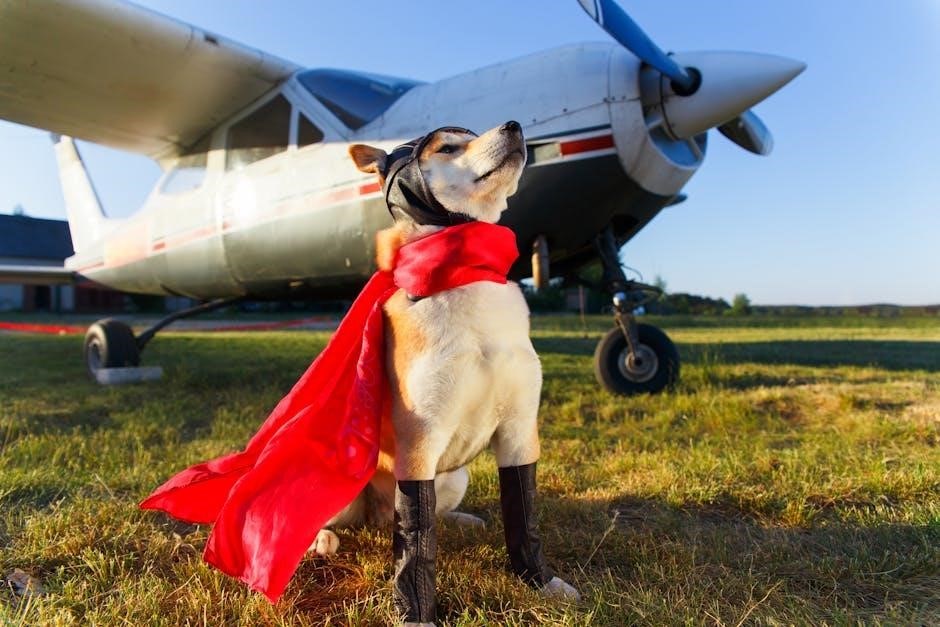A proper-fitting flight suit is essential for comfort, mobility, and safety. This guide helps you navigate sizing options, ensuring the best fit for various body types and needs.
1.1 Importance of Proper Fit in Flight Suits
A proper fit in flight suits is crucial for comfort, mobility, and safety. A well-fitting suit ensures ease of movement, preventing restrictions during critical operations. It also enhances comfort over long periods, reducing fatigue. Improper fit can lead to discomfort, restricted blood flow, or limited range of motion, which can compromise performance and safety. Ensuring the right fit is essential for optimal functionality and wearer confidence in high-stress environments.
1.2 Overview of Flight Suit Types and Their Sizing Needs
Flight suits vary in type, each with unique sizing requirements. Nomex suits, commonly used by pilots, offer fire resistance and require sizing that accounts for undergarments. Unisex options provide a universal fit, while women’s suits are tailored for female body proportions. Each type has specific measurement guidelines to ensure comfort and functionality. Understanding these differences helps in selecting the right suit for individual needs and operational demands, ensuring both safety and performance.

Measurement Guidelines for Flight Suits
Accurate measurements are crucial for a proper fit. Measure chest, waist, hips, sleeve length, and inseam. Consider body type and measure over undergarments for the best fit.
2.1 How to Measure Chest, Waist, and Hips
Use a flexible tape measure to determine chest, waist, and hip measurements. For the chest, measure around the fullest part, keeping the tape level. The waist is measured at the narrowest point, and hips at the widest part, about 7-9 inches below the waistline. Ensure the tape is snug but not tight. Measure over the undergarments you plan to wear, as this affects fit. Accurate measurements ensure a comfortable and functional flight suit fit for all body types.
2.2 Measuring Sleeve and Inseam Lengths
Measure sleeve length from the center back of the neck, over the shoulder, and down to the wrist. For inseam, measure from the crotch to the bottom of the ankle. Ensure the tape is straight and not twisted; Sleeve lengths typically range from 21–25 inches for small to extra-large sizes, while inseam lengths range from 28–32 inches. Accurate measurements ensure proper fit, allowing for maximum mobility and comfort during flight operations.
2.3 Factors Affecting Fit: Body Type and Undergarments
Body type significantly impacts flight suit fit. Muscular builds may require larger sizes, while taller individuals need longer sleeves and inseams. Undergarments, including compression gear, can add bulk, affecting measurements. Always measure over the clothing you’ll wear underneath. Layering thickness and personal comfort preferences should also be considered. Ensure accuracy by accounting for these factors to achieve the best fit for optimal performance and comfort.

Standard Flight Suit Size Charts
Standard size charts provide foundational guidance, covering chest, waist, sleeve, and inseam measurements. These charts serve as a baseline for determining the ideal fit for most individuals.
3.1 Men’s Flight Suit Size Chart
The men’s flight suit size chart categorizes sizes from Small to 4XL, based on chest, waist, and inseam measurements. Small fits chests 33-37 inches, while 4XL accommodates up to 60 inches. Sleeve and inseam lengths vary, ensuring proper fit for different body types. Measurements should be taken over undergarments for accuracy. Always refer to the manufacturer’s specific chart for precise sizing, as variations may occur between brands.
3.2 Women’s Flight Suit Size Chart
The women’s flight suit size chart offers sizes from X-Small to 3XL, catering to various body types. Measurements are based on chest, waist, and inseam lengths. For example, X-Small fits chests up to 33 inches, while 3XL accommodates up to 54 inches. Ensure accurate measurements by wearing undergarments and considering layered clothing. Proper fit is crucial for mobility and comfort during operations. Always consult the manufacturer’s specific chart for precise sizing details.
3.3 Unisex and Universal Sizing Options
Unisex and universal flight suits offer adaptable sizing, catering to diverse body types. These options often range from Small to 4XL, ensuring a broad fit range. Adjustable features like waist straps and cuffs allow customization. When choosing unisex sizes, measure over undergarments and consider layered clothing. Always refer to the manufacturer’s chart, as universal sizing can vary. Proper fit ensures comfort and mobility, making these suits ideal for professionals requiring versatility in their gear.

Understanding Sizing Rules
Proper sizing ensures comfort, mobility, and safety. Always size up for layering and mobility. Use your coat size as a base, adding two sizes for fit accuracy.
4.1 Rule of Thumb: Sizing Up for Mobility
A key rule for flight suits is sizing up to ensure mobility. Measure over undergarments and consider adding two sizes to your coat size for optimal comfort. Proper fit allows ease of movement and accommodates layered clothing. Always prioritize mobility and comfort to maintain performance during flights or operations. Sizing up ensures the suit isn’t restrictive, while still providing a professional fit. This approach guarantees functionality and safety in demanding environments.
4.2 How to Determine Size Based on Coat Measurements
Flight suit sizing often aligns with coat measurements, but it’s important to account for additional layers. Measure your chest and waist over undergarments to ensure accuracy. A common rule is to size up by two sizes from your coat measurement to allow for mobility and comfort. For example, if your coat size is 40, consider a flight suit size of 42. This ensures a comfortable fit while maintaining functionality and safety in dynamic environments.
Brand-Specific Sizing Differences
Different flight suit brands like Nomex, Rothco, and Metasco offer unique sizing charts, ensuring proper fit for various body types and operational needs.
5.1 Nomex Flight Suits: CWU-27/P and CWU-36/P Models
Nomex flight suits, including the CWU-27/P and CWU-36/P models, are designed for durability and safety. Their sizing charts vary slightly, with the CWU-27/P offering a more tailored fit and the CWU-36/P providing a universal size range. Both models emphasize mobility and comfort, accommodating different body types while ensuring protection. Proper measurement is crucial to select the correct size for optimal performance.
5.2 Rothco and Metasco Flight Suit Sizing Charts
Rothco and Metasco provide detailed sizing charts for their flight suits, ensuring accurate fit. Rothco’s chart includes measurements for chest, sleeve, and inseam, while Metasco focuses on universal sizing. Both brands emphasize the importance of measuring over undergarments for comfort and mobility. Their charts cater to various body types, offering a range of sizes to accommodate different needs. Proper fit is crucial for functionality and safety in flight operations.
How to Choose the Right Fit
Choosing the right fit involves measuring over undergarments, considering height and body proportions, and ensuring the suit allows full mobility for comfort during operations.
6.1 Considering Height and Body Proportions
Height and body proportions play a crucial role in selecting the right fit. Short, regular, and tall options cater to different body lengths. Measure chest, waist, and inseam over undergarments to ensure accuracy. For broader shoulders or longer torsos, consider sizing up. Pay attention to sleeve and leg lengths to avoid restrictive fits. Proper proportions ensure comfort and mobility, essential for flight operations. Always consult size charts for specific measurements.
6.2 Adjusting for Layered Clothing
When wearing layered clothing under your flight suit, ensure measurements are taken over these garments. This guarantees comfort and mobility. Consider the thickness of base layers, fleece, or jackets. Measure chest, waist, and inseam over layers to avoid tight fits. Proper adjustment ensures the suit doesn’t restrict movement or feel too tight. Account for bulkier items like thermals or tactical gear to maintain optimal fit and functionality during operations.
Common Mistakes to Avoid
Avoid measuring without undergarments and ignoring manufacturer-specific charts. These oversights can lead to poor fit, restricted mobility, and discomfort during flight operations.
7.1 Measuring Without Undergarments
Measuring without undergarments is a common mistake that can lead to a tight fit. Always measure over the clothing you plan to wear underneath, as this ensures proper mobility and comfort. Neglecting this step can result in a flight suit that feels restrictive or too snug, which can hinder movement during critical operations. Proper fit is essential for both safety and performance, so never underestimate the importance of accurate measurements.
7.2 Ignoring Manufacturer-Specific Charts
Ignoring manufacturer-specific size charts is a common error that can result in an ill-fitting flight suit. Each brand, such as Nomex or Rothco, may have unique sizing standards. Using generic charts can lead to discomfort or restricted movement. Always refer to the specific manufacturer’s chart to ensure proper fit and functionality. This step is crucial for both safety and performance in flight operations.

Final Tips for Ensuring Comfort and Mobility
Always measure over undergarments and consider your height when selecting sizes. Prioritize comfort to ensure safety and mobility. Use manufacturer-specific charts for accuracy.
8.1 Prioritizing Comfort in Flight Operations
Comfort is crucial for effective flight operations; A well-fitting flight suit reduces fatigue and allows for unrestricted movement. Proper sizing ensures optimal performance during long missions and emergencies. Always consider layering undergarments and personal fit preferences to maintain comfort. Prioritize mobility to enhance safety and efficiency in demanding environments. A comfortable fit directly impacts focus and readiness during critical tasks.
8.2 Importance of Proper Fit for Safety
A proper fit is vital for safety in flight operations. Ill-fitting suits can restrict movement or cause distractions, increasing risk during emergencies. Correct sizing ensures all safety features function optimally, such as easy access to pockets and unobstructed mobility. Loose or tight areas can compromise functionality, making a precise fit essential for maintaining safety protocols. Prioritize accuracy in measurements to ensure reliability in high-stakes environments.
A well-fitting flight suit enhances comfort, mobility, and safety. Use size charts, measure accurately, and consider layering to ensure the perfect fit for optimal performance and protection.
9.1 Recap of Key Sizing Principles
Flight suit sizing requires careful measurement of chest, waist, hips, sleeves, and inseam. Consider body type, undergarments, and layering. Size charts vary by brand, so refer to manufacturer guidelines. A common rule of thumb is to size up for mobility. Proper fit ensures comfort, safety, and functionality, making it crucial for pilots and crew members.
9.2 Encouragement to Use Size Charts Effectively
Using size charts effectively ensures a well-fitting flight suit, enhancing comfort and safety. Measure carefully, consider body type, and account for layered clothing. Manufacturer-specific charts provide accurate guidance. Don’t hesitate to size up for mobility. Proper fit is crucial for performance and safety, making size charts an invaluable tool for pilots and crew members.
